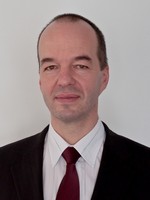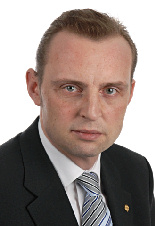Call for Papers
Important Dates
Keynote Speakers
Special Sessions
Student Session
Paper Submission
Technical Program
Registration
Venue
Travel Information
Accommodation
Committees
Patrons
ELMAR History
KEYNOTE AND DISTINGUISHED SPEAKERS
|
Feature Extraction and Classification by Prof. Miloš Oravec Institute of Computer Science |
|
Existing and Near Future Work in CEPT on Thomas Weber European Communications Office |
Feature Extraction and Classification by
Machine Learning Methods for Biometric
Recognition of Face and Iris
Prof. Miloš Oravec
Institute of Computer Science
Faculty of Electrical Engineering and Information Technology
Slovak University of Technology in Bratislava
Slovakia
Abstract:
Biometric recognition became an integral part of our living. This presentation deals with machine learning methods for recognition of humans based on face and iris biometrics.
The main intention of machine learning area is to reach a state when machines (computers) are able to respond without humans explicitly programming them. This area is closely related to artificial intelligence, knowledge discovery, data mining and neurocomputing. We present relevant machine learning methods with main focus on neural networks. Some aspects of theory of neural networks are addressed such as visualization of processes in neural networks, internal representations of input data as a basis for new feature extraction methods and their applications to image compression and classification.
Machine learning methods can be efficiently used for feature extraction and classification and therefore are directly applicable to biometric systems. Biometrics deals with the recognition of people based on physiological and behavioral characteristics. Biometric recognition uses automated methods for recognition and this is why it is closely related to machine learning.
Face recognition is discussed in this presentation - it covers the aspects of face detection, detection of facial features, classification in face recognition systems, state-of-the-art in biometric face recognition, face recognition in controlled and uncontrolled conditions and single-sample problem in face recognition. Iris recognition is analyzed from the point of view of state-of-the art in iris recognition, 2D Gabor wavelets, use of convolutional kernels and possibilities for the design of new kernels. Software and hardware implementations of face and iris recognition systems are discussed and an implementation of a multimodal interface (face and iris part of a system) is presented. Also a contribution of Machine Learning Group working at FEI SUT Bratislava (http://www.uim.elf.stuba.sk/kaivt/MLgroup) to this research area is shown.
About the Keynote Speaker:
Milos ORAVEC was born in Bratislava, Slovakia. He received the MSc. degree in telecommunication engineering, PhD. degree in applied informatics, and prof. degree in cybernetics from Faculty of Electrical Engineering and Information Technology, Slovak University of Technology (FEI SUT), Bratislava, Slovakia in 1990, 2002 and 2014, respectively. He is the vice-dean responsible for MSc study and member of the Scientific Council of the Faculty. He is with the Institute of Computer Science and Mathematics of Slovak University of Technology, Slovakia. He spent several research stays abroad, e.g. RWTH Aachen, Germany, Politecnico di Torino, Italy, Universitat Politecnica de Catalunya, Barcelona, Spain.
He is the author of over 100 scientific papers. His work has been published also in several books, e.g. Selected Methods of data Compression (Faber, Bratislava, 1996), Neural Networks for Digital Signal Processing (Faber, Bratislava, 1998), awarded by Literature Foundation of Ministry of Culture of the Slovak Republic, the chapter in Speech, Audio, Image and Biomedical Signal Processing using Neural Networks (Springer Verlag, Germany, 2008), the chapter in Face Recognition (INTECH, Croatia, 2010), and the chapter in Reviews, Refinements and New Ideas in Face Recognition (IN-TECH, Croatia, 2011). He also edited the book Face Recognition (INTECH, Croatia, 2010). He is also an author or co-author of the monographs Machine Learning Methods for Feature Extraction and Pattern Recognition I, II (Felia, Bratislava, 2012 and 2013).
He is a member of IEEE and IET. His research interests include artificial intelligence, machine learning and neural networks, biometrics, data analysis and prediction, signal processing, and communication networks. He is active in Machine Learning Group on FEI SUT Bratislava.
He acts as the reviewer for several scientific journals, e.g. IEEE Transactions on Vehicular Technology ISSN 0018-9545, IEE Proceedings on Science, Measurement and Technology ISSN 1751-8822, Sensors ISSN 1424-8220, Radioengineering (Czech Republic, ISSN 1210-2512), Journal of Electrical Engineering (Slovakia, ISSN 1335-3632), Acta Electrotechnica et Informatica (Slovakia, ISSN 1335-8243). He also acts as the editor for Central European Journal of Computer Science (CEJCS) .
Existing and Near Future Work in CEPT on
Cognitive Radio Solutions
Thomas Weber
European Communications Office
Copenhagen
Denmark
Abstract:
This paper informs about the existing and near future work in the CEPT , i.e. 48 European National regulatory authorities, responsible for spectrum management in Europe on cognitive radio (CR) solutions; in particular on the work on regulatory approaches for wireless applications under general authorization regime (i.e. commonly called license exempt); Cognitive techniques need to be analyzed not only from the perspective of the technical feasibility but also from the perspectives of the demand, fit to application and investment requirements, the level of technical complexity involved, and the long term predictability of the spectrum access.
About the Keynote Speaker:
Thomas Weber joined the European Communications Office (ECO) of the CEPT (European Conference of Postal and Telecommunications Administrations) in 2010 as expert for spectrum management and is the chairman of the WG FM Maintenance Group on Short Range Devices (SRD/MG) in the CEPT. He is also responsible for the frequency management project teams in the WGFM dealing with spectrum monitoring, PMR/PAMR, satellite services, direct-air-to-ground communications and the European Common Allocations Table.
Before that, he worked for the Federal Network Agency in Germany in 2001-2010 and was the chairman of several ETSI standardisation groups dealing with ITS (Intelligent Transportation Systems), PMR (Professional Mobile Radio), DMR (Digital Mobile Radio), GSM-R (GSM for railways) and UWB (Ultra-Wideband) as well as the chairman for the DIN/DKE German National standardisation committee on radio devices. He also worked several years for several satellite operators and in the industry in satellite communications. He holds a degree in Communications Engineering acquired at the University of Applied Sciences in Dieburg, Germany.
